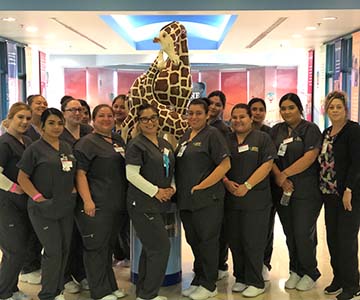Clinical Medical Assisting students get an in-depth look at hospital operation
 Corinna Avina, Clinical Medical Assisting instructor on SJVC’s Hanford campus, knows that the best way for her students to imagine themselves working in a busy medical environment is to get them behind-the-scenes. She was able to arrange that close-up through an extensive tour of Valley Children’s Hospital in Madera.
Corinna Avina, Clinical Medical Assisting instructor on SJVC’s Hanford campus, knows that the best way for her students to imagine themselves working in a busy medical environment is to get them behind-the-scenes. She was able to arrange that close-up through an extensive tour of Valley Children’s Hospital in Madera.
Clinical Medical Assisting students spend much of their education and training in a balance of classroom study and hands-on experience, but the twice-yearly trips into the physical environment of their chosen career bring their career hopes into clear reality.
“These visits give them a glimpse of what they’ll be getting into and what the many different departments look like,” says Corinna. “During the tour they observe, ask questions and get a little insight from this experience.”
Many medical and treatment facilities open their doors to these visits to boost student knowledge and encourage interest in their business. Throughout the years, students have toured hospitals and departments that include cardiology, sonography, cancer treatment, outpatient care centers, medical research centers, diagnostic laboratories, nursing care facilities and blood banks, as well as medical care insurance carriers, County Juvenile Hall, prison and corrections facilities.
“We go anywhere medical assistants can be hired,” says Corinna. “As an instructor, it is pure joy to see my students getting excited about learning and interacting.”
On-site representatives are always generous in answering students’ questions and exposing them to the inner workings of their facilities. Valley Children’s Hospital (VCH) was equally enthusiastic.
“Our students were very impressed with the hospital,” says Corinna. “And they were excited that they got to see a Doppler ultrasound that showed them what a baby’s heart looked like. Dr. Miguel Restrepo (cardiologist) also talked to them about his private practice and what they would be doing as a medical assistant for his office and what they could look forward to. He told them that a medical assistant is one of the most important positions in a doctor’s office because they are the right hand of the doctors.”
Visiting students were awed by what the surgeon shared with them and appreciative of his time and interest. “Dr. Restrepo was in between surgeries and took the time to talk with our students and give them insight into working in this field,” says Corinna.
Observing medical conditions using very sophisticated equipment and technology fascinated students and stoked their career interests.
“We also encountered a sonographer who was able to show us the heart through a specialized machine,” says Diana Rios, Clinical Medical Assisting student. “We were able to see the direction of blood flow in the heart, as well as what a leaking valve can look like in a patient.”
Clinical Medical Assisting students were also deeply touched by the children at Valley Children’s Hospital, especially those who were there for cancer treatment.
“The place that really touched my heart was the Craycroft (department for young cancer patients),” says Stephanie Gomez, Clinical Medical Assisting student. “This is the place where all the children with cancer are. Cancer has really impacted my family. I’ve lost my grandmother and recently a cousin with pancreatic cancer last year. Knowing that more than 200 kids (at VCH) are with cancer really hit me. We sometimes exaggerate with a little cold or a cough and these kids have to be brave and go through all of the medications, treatments, and even chemo.”
Several students came away from the visit with an interest in one day working at Valley Children’s Hospital. “Valley Children’s has tutors for kids who are still attending class, so they don’t fall behind,” says Simona Molina, Clinical Medical Assisting student. “They have people who volunteer their time to cuddle the babies. They try to help the families out too, the best way that they can. It made me consider working there when I am done attending school.”
This is the impact instructors hope on-site visits have on their students. These visits can spur mental pictures of a life walking similar halls. Sometimes there is a jolt of recognition of what it will take to get there from here.
“I think one of the ways this tour impacted my future career as a medical assistant was it showed me just how hard I will have to work to be successful,” says Diana. “And I learned that this is another route I can take with my future career as a medical assistant.”
Students went home with lasting impressions of their future careers. “I will see different cases that I might relate to,” says Stephanie. “It’s not a simple job. I will have to give my all to make sure the patient gets treated the way they should.”
A strong effort is undoubtedly required. “They (Clinical Medical Assisting students) get a first-hand look at what the real work-place looks like,” says Corinna. “I always inspire students to do their best and never give up, because failure is not an option.”
You might also like
More stories about
Request Information
All fields using an asterik (*) are required.


